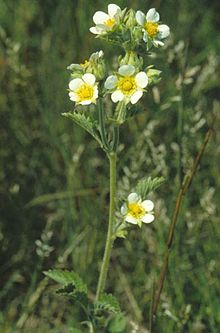- Drymocallis arguta
-
Drymocallis arguta 
Scientific classification Kingdom: Plantae (unranked): Angiosperms (unranked): Eudicots (unranked): Rosids Order: Rosales Family: Rosaceae Genus: Drymocallis Species: D. arguta Binomial name Drymocallis arguta
(Pursh) Rydb.Synonyms Potentilla arguta Pursh
Drymocallis arguta, commonly known as the tall cinquefoil or sticky cinquefoil, is a perennial plant in the Rosaceae family of flowering plants native to North America. It was formerly included with the typical cinquefoils in the genus Potentilla.
There are two accepted subspecies:[1]
- Drymocallis arguta subsp. arguta – tall cinquefoil proper
- Drymocallis arguta subsp. convallaria – cream cinquefoil
D. arguta is thought to be a protocarnivorous plant. In his 1999 journal article, G.G. Spoomer tested several plants in the Pacific Northwest for the carnivorous syndrome, using the digestion of proteins as the diagnostic tool to determine which plants appeared to produce protease enzymes capable of breaking down potential prey. D. arguta displayed a capability to digest and absorb the 14C-labeled algal protein placed on the sticky trichomes that the plant possesses. However, it is not known whether the digestive enzymes were produced by the plant itself or surface microbes.[2] Additionally, some definitions of carnivory require the plant to gain some tangible benefit in capturing and digesting prey, such as increased seed yield or growth. Such an experiment has not been done with this species.
See also
- Geranium viscosissimum another protocarnivorous plant.
References
- ^ USDA, NRCS. (2007). Potentilla arguta. The PLANTS Database (http://plants.usda.gov, 17 March 2007). National Plant Data Center, Baton Rouge, LA 70874-4490 USA.
- ^ Spoomer, G.G. (1999). Evidence of protocarnivorous capabilities in Geranium viscosissimum and Potentilla arguta and other sticky plants. International Journal of Plant Sciences, 160(1): 98-101.
Categories:- Rosoideae
- Native Forbs of Ontario
- Rosales stubs
Wikimedia Foundation. 2010.
